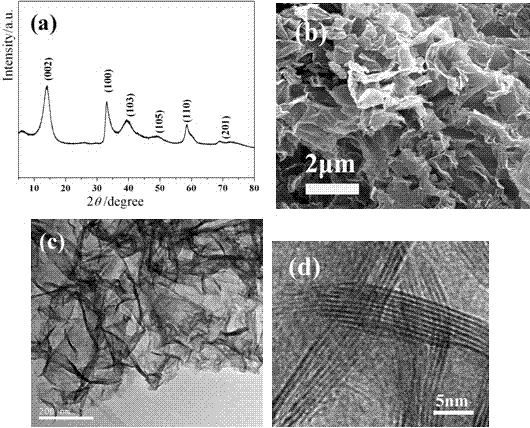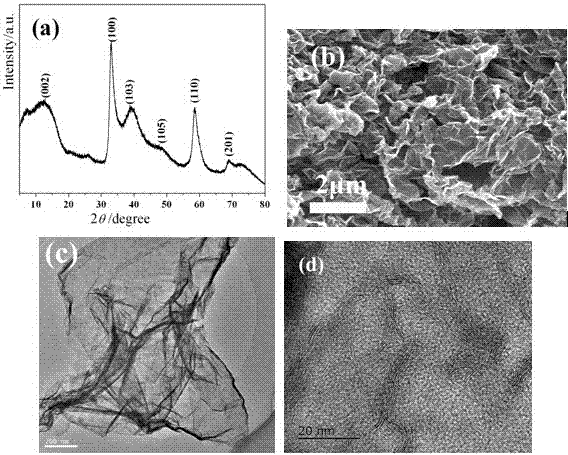A graphene-like ws 2 Preparation method of nitrogen/phosphorus co-doped graphene electrochemical sodium storage composite electrode
A composite electrode, ene electrochemical technology, applied in battery electrodes, circuits, electrical components, etc., can solve the problem of low phosphorus doping in phosphorus-doped graphene, difficulty in adsorbing graphene oxide, uneven doping, etc. It is easy to expand industrial application, convenient to expand industrial application, and enhance the performance of electrochemical sodium storage.
- Summary
- Abstract
- Description
- Claims
- Application Information
AI Technical Summary
Problems solved by technology
Method used
Image
Examples
Embodiment 1
[0030] A graphene-like WS 2 The preparation method of nitrogen / phosphorus co-doped graphene electrochemical sodium storage composite electrode comprises the following steps:
[0031] S1. Ultrasonic disperse 3 mmol of graphene oxide in 45 mL of deionized water, then add 2 mmol of tetraphenylphosphine bromide and stir thoroughly for 12 hours, then add 1.5 mmol of ammonium thiotungstate and 15 mL of hydrazine successively, and Stir continuously to completely dissolve the ammonium thiotungstate;
[0032] S2. Transfer the mixed solution obtained in S1 to a 100 mL hydrothermal reaction kettle, put the reaction kettle in a constant temperature oven, conduct a hydrothermal reaction at 240°C for 24 hours, let it cool down to room temperature naturally, and collect the solid product by centrifugation , and fully washed with deionized water, vacuum-dried at 80°C; then the solid product obtained above was heat-treated at 800°C for 2 hours in a nitrogen atmosphere to prepare graphene-like...
Embodiment 2
[0038] A graphene-like WS 2 The preparation method of nitrogen / phosphorus co-doped graphene electrochemical sodium storage composite electrode comprises the following steps:
[0039] S1. Ultrasonic disperse 3 mmol of graphene oxide in 45 mL of deionized water, then add 4.5 mmol of tetraphenylphosphine bromide and stir thoroughly for 12 hours, then add 1.5 mmol of ammonium thiotungstate and 15 mL of hydrazine successively, and Stir continuously to completely dissolve the ammonium thiotungstate;
[0040] S2. Transfer the mixed solution obtained in S1 to a 100 mL hydrothermal reaction kettle, put the reaction kettle in a constant temperature oven, and let it cool down to room temperature naturally after hydrothermal reaction at 220°C for 24 hours, and collect the solid by centrifugation product, and fully washed with deionized water, vacuum-dried at 80 °C; then the solid product obtained above was heat-treated at 700 °C for 2 hours in a nitrogen atmosphere to prepare graphene-li...
PUM
| Property | Measurement | Unit |
|---|---|---|
| quality score | aaaaa | aaaaa |
Abstract
Description
Claims
Application Information
 Login to View More
Login to View More - R&D
- Intellectual Property
- Life Sciences
- Materials
- Tech Scout
- Unparalleled Data Quality
- Higher Quality Content
- 60% Fewer Hallucinations
Browse by: Latest US Patents, China's latest patents, Technical Efficacy Thesaurus, Application Domain, Technology Topic, Popular Technical Reports.
© 2025 PatSnap. All rights reserved.Legal|Privacy policy|Modern Slavery Act Transparency Statement|Sitemap|About US| Contact US: help@patsnap.com


